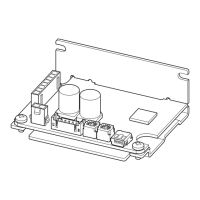12
Connection
6.4 Driver I/O circuit
Input signals circuit
Input signals of the driver are C-MOS inputs.
The signal state represents "ON: 0 to 0.5 V (L level)" and
"OFF: 4 to 5 V (H level)."
R
+5 V
10 kΩ
0 V
Input signal
GND
C-MOS
C
z
Changing the logic level setting of input signals
The logic level setting for input terminals D-IN0 to D-IN4 can be changed using the
MEXE02
or RS-485 communication.
Refer to p.55 for details.
Output signals circuit
Output signals of the driver are transistor open-collector
outputs. The signal state represents a state of "ON:
Carrying current" or "OFF: Not carrying current" for the
internal transistor rather than the voltage level of the
signal.
ON voltage: 0.5 VDC maximum
External power supply: 4.5 to 26.4 VDC, 10 mA or less
0
V
Output signal
GND
R∗
*
Recommended resistance value when a current limiting
resistor R is connected:
For 24 VDC: 2.7 k
Ω
to 4.7 k
Ω
(1 W)
For 5 VDC: 560
Ω
to 820
Ω
(0.25 W)
z
Changing the logic level setting of output signals
The logic level setting for output terminals D-OUT0 and D-OUT1 can be changed using the
MEXE02
or RS-485
communication.
However, if the SPEED-OUT output is assigned, it cannot be changed.
Refer to p.55 for details.
Note
•
Be sure to suppress a current owing to the output circuit to 10 mA or less.
Connect a current limiting resistor R externally if the current exceeds this specied value.
If the driver is used without connecting a current-limiting resistor, it will be damaged.
•
When a relay (inductive load) is connected, provide a control measure for
the y-back voltage against the relay by connecting a diode. Or use a relay
with built-in ywheel diode.
Inductive load
Fly
R
Timing chart when power is input
Signal is output
OFF
ON
OFF
Output signal
1.0 s or less
1.0 s or more
Input enabled
ON
Input signal

